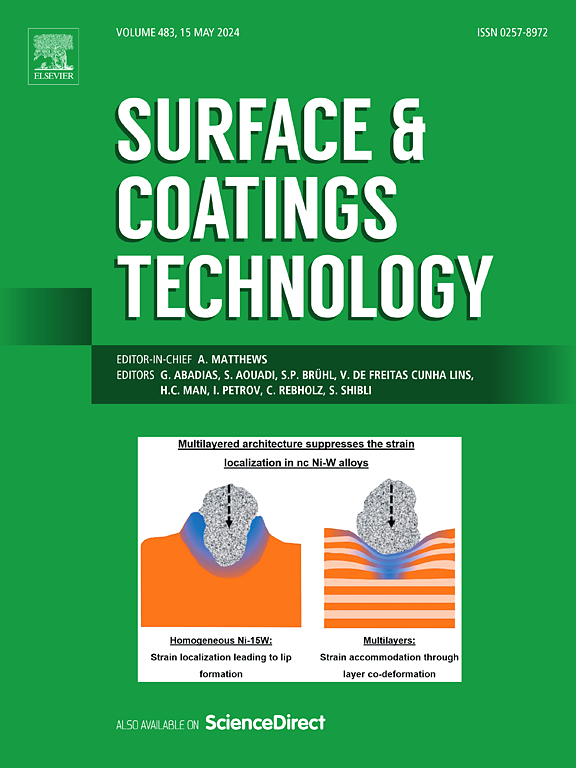常规与超高速激光熔覆修复EA4T铁路车轴钢Ni625合金组织与力学性能的对比研究
IF 5.3
2区 材料科学
Q1 MATERIALS SCIENCE, COATINGS & FILMS
引用次数: 0
摘要
比较了常规激光熔覆(CLC)和超高速激光熔覆(UHSLC)修复EA4T铁路轴钢Ni625合金涂层的显微组织和力学性能。结果表明,在典型工艺条件下,与CLC相比,UHSLC工艺具有更低的热输入和更快的冷却速度,显著提高了包层效率,减小了衬底热影响区(HAZ)的尺寸。与CLC试样相比,UHSLC涂层表现出更均匀、更细的晶粒,稀释率显著降低。UHSLC涂层的硬度更高,约为300 HV,而CLC涂层的硬度为275 HV。在拉伸试验中,UHSLC试样的极限抗拉强度和屈服强度更接近基材,断裂模式呈现韧脆混合特征。相比之下,CLC试样更容易在涂层-基体界面处萌生裂纹,表现出更高的脆性和更大的残余应力。UHSLC工艺在细化晶粒结构、减小热影响区尺寸和降低残余应力方面优于CLC工艺。这些优点为铁路轴钢后续改型工艺参数的选择和优化提供了理论依据。本文章由计算机程序翻译,如有差异,请以英文原文为准。

Comparative study on the microstructure and mechanical properties of Ni625 alloy deposited by conventional and ultra-high-speed laser cladding for the repairing of EA4T railway axle steel
This study compares the microstructure and mechanical properties of Ni625 alloy coatings produced by conventional laser cladding (CLC) and ultra-high-speed laser cladding (UHSLC) for the repair of EA4T railway axle steel. The results demonstrate that the UHSLC process, characterized by lower heat input and faster cooling rates, significantly improves cladding efficiency and reduces the size of the heat-affected zone (HAZ) in the substrate compared to CLC under typical processing conditions. The UHSLC coating exhibits more uniform and finer grains, with a significantly lower dilution rate compared to the CLC specimen. The hardness of the UHSLC coating is higher, approximately 300 HV, compared to 275 HV for the CLC coating. In tensile testing, the ultimate tensile strength and yield strength of the UHSLC specimen are closer to the base material, and the fracture mode shows ductile-brittle mixed characteristics. In contrast, the CLC specimens are more prone to crack initiation at the coating-substrate interface, exhibiting higher brittleness and larger residual stresses. The UHSLC process demonstrates significant advantages over the CLC process by refining the grain structure, reducing the size of the HAZ, and lowering residual stresses. These benefits provide a theoretical foundation for the selection and optimization of parameters in subsequent modification processes for railway axle steel.
求助全文
通过发布文献求助,成功后即可免费获取论文全文。
去求助
来源期刊

Surface & Coatings Technology
工程技术-材料科学:膜
CiteScore
10.00
自引率
11.10%
发文量
921
审稿时长
19 days
期刊介绍:
Surface and Coatings Technology is an international archival journal publishing scientific papers on significant developments in surface and interface engineering to modify and improve the surface properties of materials for protection in demanding contact conditions or aggressive environments, or for enhanced functional performance. Contributions range from original scientific articles concerned with fundamental and applied aspects of research or direct applications of metallic, inorganic, organic and composite coatings, to invited reviews of current technology in specific areas. Papers submitted to this journal are expected to be in line with the following aspects in processes, and properties/performance:
A. Processes: Physical and chemical vapour deposition techniques, thermal and plasma spraying, surface modification by directed energy techniques such as ion, electron and laser beams, thermo-chemical treatment, wet chemical and electrochemical processes such as plating, sol-gel coating, anodization, plasma electrolytic oxidation, etc., but excluding painting.
B. Properties/performance: friction performance, wear resistance (e.g., abrasion, erosion, fretting, etc), corrosion and oxidation resistance, thermal protection, diffusion resistance, hydrophilicity/hydrophobicity, and properties relevant to smart materials behaviour and enhanced multifunctional performance for environmental, energy and medical applications, but excluding device aspects.
 求助内容:
求助内容: 应助结果提醒方式:
应助结果提醒方式:


